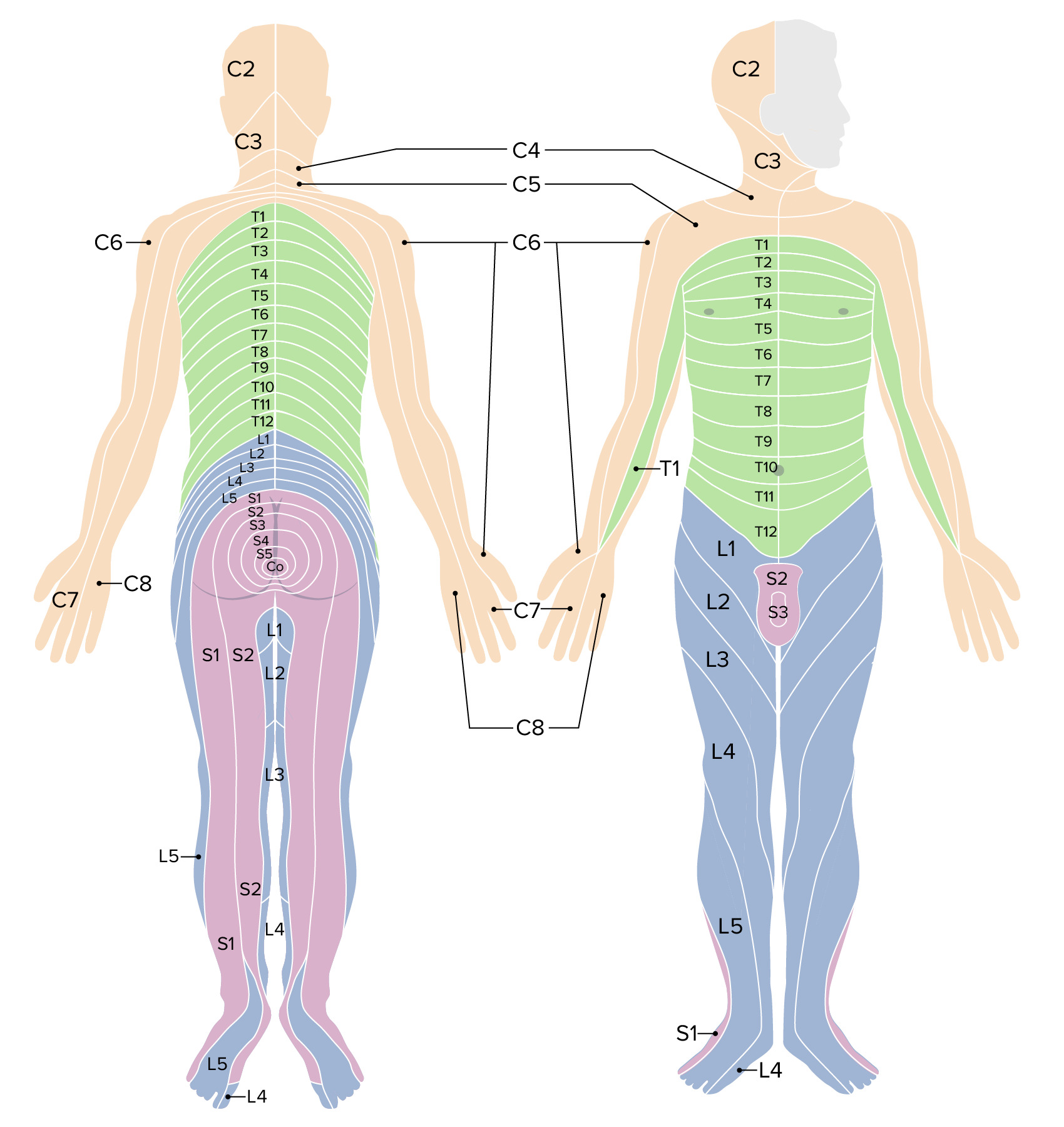Playlist
Show Playlist
Hide Playlist
Rexed Laminae and Spinal Cord Tracts
-
Slides 3 SpinalCord1 BrainAndNervousSystem.pdf
-
Reference List Anatomy.pdf
-
Download Lecture Overview
00:01 Now, I want you to understand the fact that the gray matter is divided into finer divisions. We looked at dorsal, ventral, and intermediate horns. But the gray matter is divided into divisions that are referred to as Rexed laminae. These are going to number I through X. I will be located most dorsally. IX is located out here ventrally. Then X is going to be in an area of decussation of axons. Now, I want you to understand some of the basic functions that are associated with these Rexed laminae. First, we’re going to bundle Rexed laminae I through IV together. You can see where they’re located within the dorsal gray horn or dorsal horn. These are responsible for exteroceptive sensations. Here you’re receiving information from the periphery of the body as it might relate to fine touch, temperature, vibration, or pressure. 01:12 Rexed laminae V and VI shown here and here are responsible for proprioceptive sensation. These also serve as a relay between the midbrain and the cerebellum. Rexed lamina number VI also will have some neurons that will give rise to the spinocerebellar pathways. This will be ascending in nature. Number VII shown in through here would only be found where you have visceral motor output, sympathetic motor output. So you’re looking at this particular lamina being found in spinal cord segments T1 through T12, L1, L2 and perhaps L3. VIII and IX are shown here and here. These Rexed laminae are responsible for final motor output to the periphery. Then lastly, between the right and left gray horns, you have this more centrally located area where you have a decussation of axons between the right and left sides. 02:28 If we highlight specifically Rexed lamina number IX, again this is coordinating final motor output along with VIII but in Rexed lamina number IX, there is a topographic organization by motor function. 02:47 Here you’re going to find alpha and gamma motor neurons. There are two rules for you to remember about this topographic organization by function. One is the proximal to distal rule. What we have here in the upper limb within Rexed lamina number IX, the more proximal musculature of the upper limb is found medially. The distal musculature of the upper limb is found more laterally. The proximal to distal rule is topographic organization is then medial to lateral. There’s also a flexor extensor rule regarding this topographic organization. That is the flexors, in this case the upper limb are oriented more posteriorly within the Rexed lamina number IX, whereas extensor muscles become arranged so that they are more anteriorly located within this Rexed lamina. Now, I want you to understand that the spinal cord tracts are going to be involved in transmitting or conveying functional information. This functional information can be ascending, going from the spinal cord upwards to higher brain centers such as the cerebral cortex. You can have functional information being conveyed in a descending manner coming from the cerebral cortex, for example, down to the level of the spinal cord. Highlighted in blue are various ascending pathways or tracts. An example here would be the lateral spinothalamic tract shown in through here. You’d also have, yet as another example, the anterior spinothalamic tract. These are conveying sensory information from the cord level which is receiving information from the periphery and then sending that up to the cerebral cortex so that it may be perceived. The other type of functional transmission is going to be descending in nature and this is conveying motor information. Some of the examples here are shown in red. This would be your lateral corticospinal tract, for example, here. 05:24 Then this one arranged here would be your anterior corticospinal tract. So you want to be able to use these tracts to innervate your peripheral skeletal musculature.
About the Lecture
The lecture Rexed Laminae and Spinal Cord Tracts by Craig Canby, PhD is from the course Spinal Cord. It contains the following chapters:
- Rexed Laminae
- Spinal Cord Tracts
Included Quiz Questions
Which of the following statements regarding the distribution of Rexed laminae in gray matter is INCORRECT?
- Rexed Laminae V–X are located in the dorsal column.
- Rexed Lamina X is located in the area of decussation of neurons.
- Rexed Laminae VIII—IX are located in the ventral horn.
- Rexed Laminae I—IV are located in the dorsal horn.
- Rexed Lamina I is located most dorsally, and Rexed Laminae IX is located most ventrally.
Which of the following combinations of the Rexed laminae does NOT match with their corresponding functions?
- X: Relay between midbrain and cerebellum
- V—VI: Proprioception
- I—IV: Fine touch, temperature, and vibration
- VII: Visceral motor output
- VIII—IX: Final motor output
Which of the following statements BEST describes the Rexed lamina IX?
- Innervation to proximal muscles of the upper limbs arises from the more medial aspect.
- The flexors of the upper limbs are oriented more anteriorly.
- Innervation to the distal muscles of the upper limbs arises from the more medial aspect.
- Innervation to proximal muscles of the upper limbs arises from the more lateral aspect.
- Extensors of the upper limbs are oriented more posteriorly.
In which of the following parts of the spinal cord is the Rexed lamina VII located?
- T1–T12
- T1–T4
- T1–T8
- C2-3
- C1–C7
Customer reviews
5,0 of 5 stars
| 5 Stars |
|
1 |
| 4 Stars |
|
0 |
| 3 Stars |
|
0 |
| 2 Stars |
|
0 |
| 1 Star |
|
0 |
The lecturer made the laminae look simple and memorable and definitely gotta be watched by peers since it gives a simple breaking down of presentation that makes it more easier to store it up.




